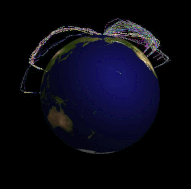Wolfram Community Highlights: Shadow Mapping, Pairs Trading, the Puzzled Ant and More



Wolfram Community recently surpassed 15,000 members! And our Community members continue to impress us. Here are some recent highlights from the many outstanding Community posts.
BVH Accelerated 3D Shadow Mapping, Benjamin Goodman

Shade data converted to solar map
In a tour de force of computational narrative and a fusion of various Wolfram Language domains, Benjamin Goodman designs a shadow mapping algorithm. It’s a process of applying shadows to a computer graphic. Goodman optimized shadow mapping via space partitioning and a hierarchy of bounding volumes stored as a graph, forming a bounding volume hierarchy.
Pairs Trading with Copulas, Jonathan Kinlay


Jonathan Kinlay, the head of quantitative trading at Systematic Strategies LLC in New York, shows how copula models can be applied in pairs trading and statistical arbitrage strategies. The idea comes from when copulas began to be widely adopted in financial engineering, risk management and credit derivatives modeling, but it remains relatively underexplored compared to more traditional techniques in this field.
The Global Terrorism Database (GTD), Marco Thiel

Marco Thiel broke a Wolfram Community record in April when he contributed four featured posts in just three days! He utilized data from the Global Terrorism Database (GTD), an open-source database including information on terrorist events around the world, starting from 1970. It includes systematic data on domestic as well as transnational and international terrorist events, amounting to more than 150,000 cases. Marco analyzes weapon types, geo distribution of attacks and casualties, and temporal and demographical behavior.
Flight Data and Trajectories of Aeroplanes, Marco Thiel

Thiel utilizes the large amounts of data becoming ever more available. Often, however, these datasets are very valuable and difficult to access. Thiel shows how to use air traffic data to generate visualizations of three-dimensional flight paths on the globe and access flight positions and altitudes, call signs, types of planes, origins, destinations and much more.
Analysing “All” of the World’s News—Database of Everything, Marco Thiel

In another clever data collection/analysis project, Thiel works with “the largest, most comprehensive, and highest resolution open database of human society ever created,” according to the description provided by GDELT (Global Database of Events, Language, and Tone). Since 2015, this organization has acquired about three-quarters of a trillion emotional snapshots and more than 1.5 billion location references. Thiel performs some basic analysis and builds supporting visualizations.
How-to-Guide: External GPU on OSX—How to Use CUDA on Your Mac, Marco Thiel

Thiel discusses the neural network and machine learning framework that has become one of the key features of the latest releases of the Wolfram Language. Training neural networks can be very time-consuming, and the Wolfram Language offers an incredibly easy way to use a GPU to train networks and also do numerous other interesting computations. This post explains how to use powerful external GPU units for Wolfram Language computing on your Mac.
Creative Routines Charts, Patrick Scheibe

People are often interested in how creative or successful individuals manage their time, and when in their daily schedules they do what they are famous for. Patrick Scheibe describes how to build and personalize “creative routines” visualizations.
QR Code in Shopping Cart Handle, Patrick Scheibe

Scheibe also brought to Wolfram Community his famous article “QR Code in Shopping Cart Handle.” It explains the image processing algorithm for reading QR code labels when they are deformed by attachment to physical objects such as shopping carts and product packages.
Calculating NMR-Spectra with Wolfram Language, Hans Dolhaine
Hans Dolhaine, a chemist from Germany, writes a detailed walk-through calculating nuclear magnetic resonance spectra with the Wolfram Language. This is a useful educational tool for graduate physics and chemistry classes. Please feel free to share it in your interactions with students and educators.
Computational Introduction to Logarithms, Bill Gosper

Another excellent resource for educators is this elementary introduction to logarithms by means of computational exploration with the Wolfram Language. The Community contributor is renowned mathematician and programmer Bill Gosper. His article is highly instructive and accessible to a younger generation, and it contains beautiful animated illustrations that serve as outstanding educational material.
Using Recursion and FindInstance to Solve Sudoku and The Puzzled Ant and Particle Filter, Ali Hashmi

Finally, Ali Hashmi uses the recursion technique coupled with heuristics to solve a sudoku puzzle and also explains the connection between the puzzled ant problem and particle filters in computer vision.
If you haven’t yet signed up to be a member of Wolfram Community, don’t hesitate! You can join in on these discussions, post your own work in groups of your interest, and browse the complete list of Staff Picks.



Comments